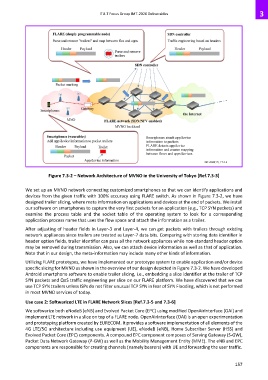Page 163 - ITU-T Focus Group IMT-2020 Deliverables
P. 163
ITU-T Focus Group IMT-2020 Deliverables 3
Figure 7.3-2 – Network Architecture of MVNO in the University of Tokyo [Ref.7.3-3]
We set up an MVNO network connecting customized smartphones so that we can identify applications and
devices from the given traffic with 100% accuracy using FLARE switch. As shown in Figure 7.3-2, we have
designed trailer slicing, where meta information on applications and devices at the end of packets. We install
our software on smartphones to capture the very first packets for an application (e.g., TCP SYN packets) and
examine the process table and the socket table of the operating system to look for a corresponding
application process name that uses the flow space and attach the information as a trailer.
After adjusting of header fields in Layer-3 and Layer-4, we can get packets with trailers through existing
network appliances since trailers are treated as Layer-7 data bits. Comparing with storing data identifier in
header option fields, trailer identifier can pass all the network appliances while non-standard header option
may be removed during transmission. Also, we can attach device information as well as that of application.
Note that in our design, the meta-information may include many other kinds of information.
Utilizing FLARE prototypes, we have implemented our prototype system to enable application and/or device
specific slicing for MVNO as shown in the overview of our design depicted in Figure 7.3-2. We have developed
Android smartphone software to enable trailer slicing, i.e., embedding a slice identifier at the trailer of TCP
SYN packets and QoS traffic engineering per slice on our FLARE platform. We have discovered that we can
use TCP SYN trailers unless ISPs do not filter unusual TCP SYN in fear of SYN Flooding, which is not performed
in most MVNO services of today.
Use case 2: Softwarized LTE in FLARE Network Slices [Ref.7.3-5 and 7.3-6]
We softwarize both eNodeB (eNB) and Evolved Packet Core (EPC) using modified OpenAirInterface (OAI) and
implement LTE network in a slice on top of a FLARE node. OpenAirInterface (OAI) is an open experimentation
and prototyping platform created by EURECOM. It provides a software implementation of all elements of the
4G LTE/5G architecture including use equipment (UE), eNodeB (eNB), Home Subscriber Server (HSS) and
Evolved Packet Core (EPC) components. A compound EPC component composes of Serving Gateway (S-GW),
Packet Data Network Gateway (P-GW) as well as the Mobility Management Entity (MME). The eNB and EPC
components are responsible for creating channels (namely bearers) with UE and forwarding the user traffic.
157

